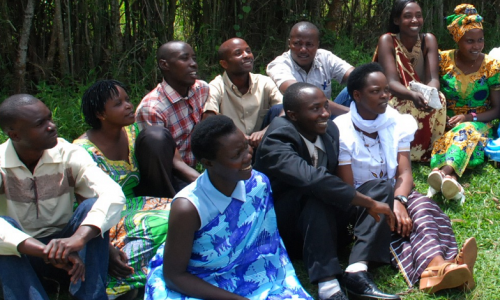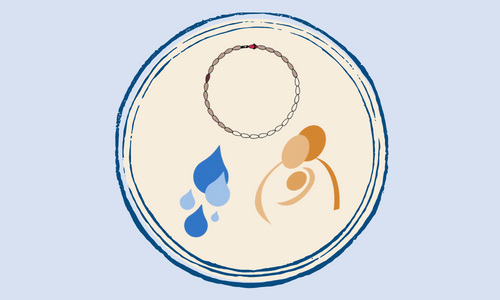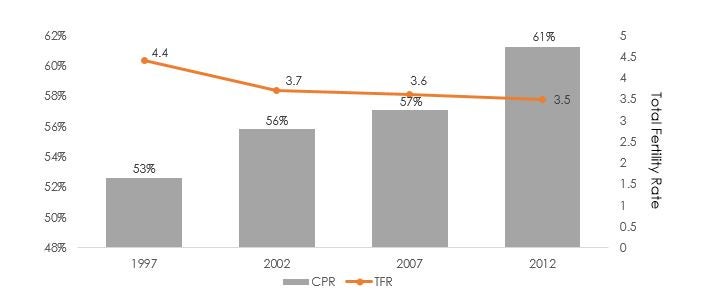Population, Plateaus, and Geopolitics: What’s up with the Fertility Stall in Jordan?
Imagine you live in a country slightly smaller than the state of Indiana. You have three children—a boy and two girls—and you have another one on the way soon. You’re hoping for a boy so you can complete your family.
Over the last decade, you’ve seen the population around you grow eight times what it used to be. Today, one out of three people you’ll see or talk to will not be a citizen of this country. In fact, while you have lived here for most of your life, you’re not a citizen either.
This describes the life of many in Jordan.
For a small country, Jordan’s stalled total fertility rate (TFR) of 3.5—the average number of children a woman will potentially have—is a problem. TFR in Jordan dropped from 6.6 in 1983 to 3.7 in 2002 according to Demographic and Health Surveys. But over the past decade, the rate has declined just slightly to 3.5, while Jordan has experienced an 87% spike in population. As of 2015, one third of Jordan’s 9.5 million people are non-Jordanians.
Trends in TFR and CPR, 1997 – 2012
Health programs, researchers, and donors in Jordan are stumped about why modern family planning uptake is stalling, especially because the country has the right mix of development variables for family planning uptake: universal knowledge of family planning methods, high female literacy, and practiced spacing of pregnancies. Stagnation is not uncommon. Both Senegal and Tanzania experienced TFR plateaus in the 2000s and both countries have now seen contraceptive prevalence rate (CPR) increases. Neighboring countries such as Egypt, Saudi Arabia, and Iran all experienced stalling over the last decade.
Why Jordan’s plateau is unusual
- Jordan’s TFR stall lasted over a decade, making it one of the longest lasting periods of stagnation recently assessed worldwide.
- Jordan’s CPR has increased slightly, but the effectiveness of the methods being used has decreased over time. Indeed, it appears that Jordanians are increasingly using traditional methods and condoms while decreasing their use of more effective methods.
- Jordan suffers from a permanent state of demographic transition as host country to refugees fleeing neighboring countries dating back to the Palestinian war of 1948. The recent Syrian conflict has resulted in more than 600,000 refugees entering Jordan, and some unofficial estimates actually place the numbers higher at about 1.2 million refugees. The latest refugee influx has placed a significant strain on public services and already scarce water resources, among others prize commodities.
Modern and Traditional Methods, by DHS Year (1997 – 2012)
As the US’s geopolitical ally, Jordan receives a sizable assistance package from the US government for military and economic programs. From 1997-2015, USAID invested close to $476 million in the overall health sector in Jordan. Much of this funding was directed toward maternal and child health and family planning programming. But since this funding package parallels the fertility plateau in Jordan, we ask: what impact did USAID programming actually have on Jordan’s family planning outcomes?
To answer this, at the request of USAID/Jordan, the Institute for Reproductive Health (IRH) at Georgetown University conducted an assessment of USAID’s family planning contributions over the last decade through a desk review of USAID programs in Jordan and interviews with reproductive health stakeholders. We explored reasons for fertility stagnation in Jordan and attempted to categorize the types of USAID family planning programming successes and challenges by posing three research questions:
- What factors drive the TFR and CPR rates stagnation in Jordan?
- How has USAID support influenced family planning uptake?
- What should guide USAID’s strategy going forward?
Stay tuned for part two of our blog series where we answer the first research question: “What’s the big deal about wanting four children? Exploring the factors behind Jordan’s fertility stall.”
 Where We Work
Where We Work  Press Room
Press Room  FACT Project
FACT Project  Passages Project
Passages Project  Learning Collaborative
Learning Collaborative  Search All Resources
Search All Resources  Social Norms
Social Norms  Fertility Awareness Methods
Fertility Awareness Methods 
